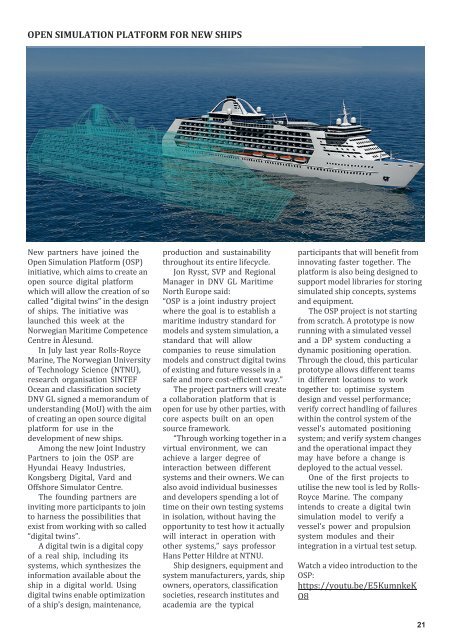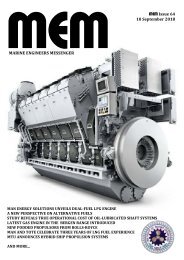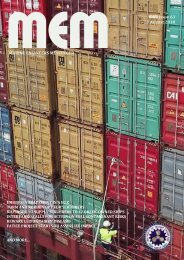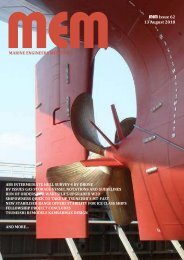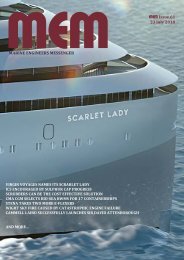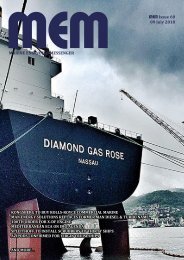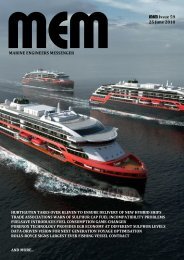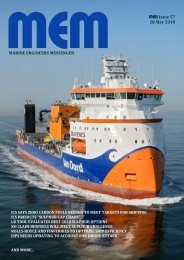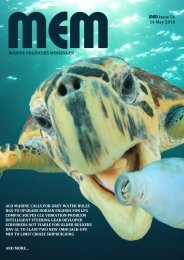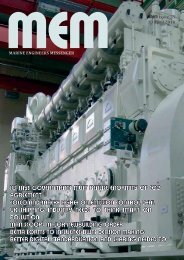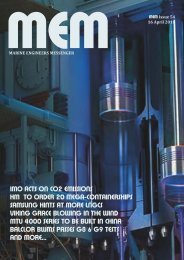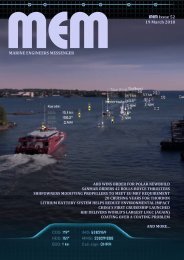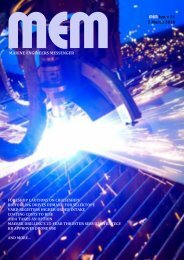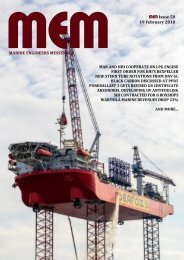You also want an ePaper? Increase the reach of your titles
YUMPU automatically turns print PDFs into web optimized ePapers that Google loves.
OPEN SIMULATION PLATFORM FOR NEW SHIPS<br />
New partners have joined the<br />
Open Simulation Platform (OSP)<br />
initiative, which aims to create an<br />
open source digital platform<br />
which will allow the creation of so<br />
called “digital twins” in the design<br />
of ships. The initiative was<br />
launched this week at the<br />
Norwegian Maritime Competence<br />
Centre in Ålesund.<br />
In July last year Rolls-Royce<br />
Marine, The Norwegian University<br />
of Technology Science (NTNU),<br />
research organisation SINTEF<br />
Ocean and classification society<br />
DNV GL signed a memorandum of<br />
understanding (MoU) with the aim<br />
of creating an open source digital<br />
platform for use in the<br />
development of new ships.<br />
Among the new Joint Industry<br />
Partners to join the OSP are<br />
Hyundai Heavy Industries,<br />
Kongsberg Digital, Vard and<br />
Offshore Simulator Centre.<br />
The founding partners are<br />
inviting more participants to join<br />
to harness the possibilities that<br />
exist from working with so called<br />
“digital twins”.<br />
A digital twin is a digital copy<br />
of a real ship, including its<br />
systems, which synthesizes the<br />
information available about the<br />
ship in a digital world. Using<br />
digital twins enable optimization<br />
of a ship’s design, maintenance,<br />
production and sustainability<br />
throughout its entire lifecycle.<br />
Jon Rysst, SVP and Regional<br />
Manager in DNV GL Maritime<br />
North Europe said:<br />
“OSP is a joint industry project<br />
where the goal is to establish a<br />
maritime industry standard for<br />
models and system simulation, a<br />
standard that will allow<br />
companies to reuse simulation<br />
models and construct digital twins<br />
of existing and future vessels in a<br />
safe and more cost-efficient way.”<br />
The project partners will create<br />
a collaboration platform that is<br />
open for use by other parties, with<br />
core aspects built on an open<br />
source framework.<br />
“Through working together in a<br />
virtual environment, we can<br />
achieve a larger degree of<br />
interaction between different<br />
systems and their owners. We can<br />
also avoid individual businesses<br />
and developers spending a lot of<br />
time on their own testing systems<br />
in isolation, without having the<br />
opportunity to test how it actually<br />
will interact in operation with<br />
other systems,” says professor<br />
Hans Petter Hildre at NTNU.<br />
Ship designers, equipment and<br />
system manufacturers, yards, ship<br />
owners, operators, classification<br />
societies, research institutes and<br />
academia are the typical<br />
participants that will benefit from<br />
innovating faster together. The<br />
platform is also being designed to<br />
support model libraries for storing<br />
simulated ship concepts, systems<br />
and equipment.<br />
The OSP project is not starting<br />
from scratch. A prototype is now<br />
running with a simulated vessel<br />
and a DP system conducting a<br />
dynamic positioning operation.<br />
Through the cloud, this particular<br />
prototype allows different teams<br />
in different locations to work<br />
together to: optimise system<br />
design and vessel performance;<br />
verify correct handling of failures<br />
within the control system of the<br />
vessel’s automated positioning<br />
system; and verify system changes<br />
and the operational impact they<br />
may have before a change is<br />
deployed to the actual vessel.<br />
One of the first projects to<br />
utilise the new tool is led by Rolls-<br />
Royce Marine. The company<br />
intends to create a digital twin<br />
simulation model to verify a<br />
vessel’s power and propulsion<br />
system modules and their<br />
integration in a virtual test setup.<br />
Watch a video introduction to the<br />
OSP:<br />
https://youtu.be/E5KumnkeK<br />
O8<br />
21


